- Car finance Car finance
- Motorbike finance Motorbike finance
- Van finance Van finance
- How it works How it works
- FAQs and guides FAQs and guides
- About us About us
- Home
- Blog
- Looking After Your Vehicle
- How to check tyre pressure
How to check tyre pressure
Updated: Friday, 12 May 2023
Your tyres arguably are one of the most important items on your vehicle for keeping you safe. Tyres make sure you are stable on the road whilst also keeping you moving. Let’s be honest, without functioning tyres the vehicle can’t take you anywhere! So how do you check your tyre pressure, when should you increase tyre pressure, and why is it so important in keeping you safe?
Your tyres arguably are one of the most important items on your vehicle for keeping you safe. Tyres make sure you are stable on the road whilst also keeping you moving. Let’s be honest, without functioning tyres the vehicle can’t take you anywhere! So how do you check your tyre pressure, when should you increase tyre pressure, and why is it so important in keeping you safe?
How to check car tyre pressure
You may have a tyre pressure gauge at home, but if you don’t then most petrol stations have them. Most of the time they are free but sometimes they cost a small fee.
Look in either the driver’s door trim or the passenger door trim to find a sticker showing what pressure your tyres should be. If you have a motorbike then there should be a sticker on the body of the bike, but if not, you will be able to find your tyre pressure in your owner’s manual.
There will be multiple options depending on the weight or amount of people you usually drive with. Most modern cars will usually suggest that your tyres should be between 32 psi to 35 psi. If it’s a vehicle that doesn’t show tyre pressure in psi then you can do a quick internet search to convert it into psi.
Whether you use a petrol station machine or a gauge you have at home, follow the below steps to learn how to check tyre pressure:
1. Remove the valve dust cap on the tyre you are wanting to check and place the gauge onto the valve.
2. Press down the gauge evenly to make sure the reading is accurate and no air is being released.
3. Check the reading to see if you need to inflate or deflate your tyres, based on your cars suggested tyre pressure.
4. Use a tyre pressure machine to either deflate or inflate your tyres.
5. Repeat on all tyres.
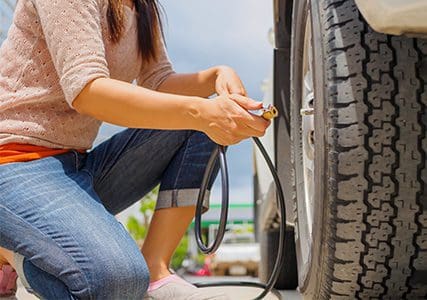
How to check car tyre pressure
You may have a tyre pressure gauge at home, but if you don’t then most petrol stations have them. Most of the time they are free but sometimes they cost a small fee.
Look in either the driver’s door trim or the passenger door trim to find a sticker showing what pressure your tyres should be. If you have a motorbike then there should be a sticker on the body of the bike, but if not, you will be able to find your tyre pressure in your owner’s manual.
There will be multiple options depending on the weight or amount of people you usually drive with. Most modern cars will usually suggest that your tyres should be between 32 psi to 35 psi. If it’s a vehicle that doesn’t show tyre pressure in psi then you can do a quick internet search to convert it into psi.
Whether you use a petrol station machine or a gauge you have at home, follow the below steps to learn how to check tyre pressure:
1. Remove the valve dust cap on the tyre you are wanting to check and place the gauge onto the valve.
2. Press down the gauge evenly to make sure the reading is accurate and no air is being released.
3. Check the reading to see if you need to inflate or deflate your tyres, based on your cars suggested tyre pressure.
4. Use a tyre pressure machine to either deflate or inflate your tyres.
5. Repeat on all tyres.

Once you know how to do it, it’s an easy task. But how often do you check tyre pressure? We would always advise you to check your tyre pressure regularly, and in some modern vehicles you will get a warning light on your dashboard telling you to check your tyre pressure. If your vehicle doesn’t tell you, then we would advise checking your tyre pressure once a month if you drive a lot, and once every 3 months if you drive a moderate amount. Checking your tyres before a long journey is also important. It should also be included when getting your car ready for the winter.
Once you know how to do it, it’s an easy task. But how often do you check tyre pressure? We would always advise you to check your tyre pressure regularly, and in some modern vehicles you will get a warning light on your dashboard telling you to check your tyre pressure. If your vehicle doesn’t tell you, then we would advise checking your tyre pressure once a month if you drive a lot, and once every 3 months if you drive a moderate amount. Checking your tyres before a long journey is also important. It should also be included when getting your car ready for the winter.
How to use a tyre pressure machine
1. Park close enough to the machine, whether this be at home or at a petrol station.
2. Set the machine to the pressure you want i.e. 32 psi.
3. Remove the valve dust cap from the tyre valve and put the pressure gauge onto the tyre valve securely so that you can no longer hear air releasing from the tyre.
4. Once the gauge is firmly and evenly placed on the valve you will get an accurate reading of the current tyre pressure. The machine will then either inflate or deflate depending on what psi you put into the machine at the beginning.
5. The machine will let you know that your tyre is now inflated to the pressure it needs to be. Put the dust cap back on the valve and repeat on the other 3 tyres.
How to use a tyre pressure machine
1. Park close enough to the machine, whether this be at home or at a petrol station.
2. Set the machine to the pressure you want i.e. 32 psi.
3. Remove the valve dust cap from the tyre valve and put the pressure gauge onto the tyre valve securely so that you can no longer hear air releasing from the tyre.
4. Once the gauge is firmly and evenly placed on the valve you will get an accurate reading of the current tyre pressure. The machine will then either inflate or deflate depending on what psi you put into the machine at the beginning.
5. The machine will let you know that your tyre is now inflated to the pressure it needs to be. Put the dust cap back on the valve and repeat on the other 3 tyres.
What should my tyre pressure be?
As mentioned above, you should be able to find what your tyre pressure is by looking in either the driver’s door trim or the passengers. If you have a motorbike, there will either be a sticker somewhere on the body of the motorbike or you can find it in your owner’s manual.
Your tyre pressure however, does depend on what tyre size you have chosen to have on your vehicle. All tyres come with a number on them that identifies the type of tyre, tread width, diameter, speed rating and more. The tyre size therefore affects the amount of air that it needs to be filled with.
There are many types of tyre pressure tools online, but we find this one from KwikFit the most useful. Just type in your registration number and it will give you all the tyre pressures for all the different tyre sizes that can be fitted to your car. Your tyre size will be written clearly on the side of your tyres for you to find the correct pressure for your tyres.
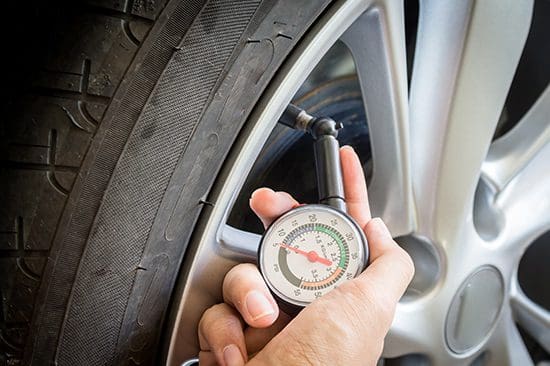
What should my tyre pressure be?
As mentioned above, you should be able to find what your tyre pressure is by looking in either the driver’s door trim or the passengers. If you have a motorbike, there will either be a sticker somewhere on the body of the motorbike or you can find it in your owner’s manual.
Your tyre pressure however, does depend on what tyre size you have chosen to have on your vehicle. All tyres come with a number on them that identifies the type of tyre, tread width, diameter, speed rating and more. The tyre size therefore affects the amount of air that it needs to be filled with.
There are many types of tyre pressure tools online, but we find this one from KwikFit the most useful. Just type in your registration number and it will give you all the tyre pressures for all the different tyre sizes that can be fitted to your car. Your tyre size will be written clearly on the side of your tyres for you to find the correct pressure for your tyres.

When should tyre pressure be checked?
Tyre pressure should be checked when your tyres are cold. Which means you shouldn’t have driven the vehicle for several hours before checking your tyre pressure. This is because the pressure inside your tyres increases as they heat up. Which means if you pump up your tyres when they are warm, their pressure will probably be too low and therefore not safe.
If you check tyre pressure at petrol stations, then we would advise going to your nearest petrol station to home so that you’ve only travelled a short distance, keeping your tyres as cold as possible.
When should tyre pressure be checked?
Tyre pressure should be checked when your tyres are cold. Which means you shouldn’t have driven the vehicle for several hours before checking your tyre pressure. This is because the pressure inside your tyres increases as they heat up. Which means if you pump up your tyres when they are warm, their pressure will probably be too low and therefore not safe.
If you check tyre pressure at petrol stations, then we would advise going to your nearest petrol station to home so that you’ve only travelled a short distance, keeping your tyres as cold as possible.
How often should you check tyre pressure?
You should check tyre pressure around once a month to check that you are driving on inflated tyres and staying safe on the roads. If you know you are about to drive a long distance it’s also advised to check them before you leave.
Checking your tyre pressure regularly can help with:
- Tyre tread – your tyres will be kept in better condition for longer.
- Flat tyres – it reduces the chances of getting a flat tyre.
- Stopping distance – correctly inflated tyres allow your car to stop safely and quickly.
How often should you check tyre pressure?
You should check tyre pressure around once a month to check that you are driving on inflated tyres and staying safe on the roads. If you know you are about to drive a long distance it’s also advised to check them before you leave.
Checking your tyre pressure regularly can help with:
- Tyre tread – your tyres will be kept in better condition for longer.
- Flat tyres – it reduces the chances of getting a flat tyre.
- Stopping distance – correctly inflated tyres allow your car to stop safely and quickly.
When would you increase the pressure in your tyres?
Depending on who and what you are travelling with, the recommended tyre pressure may increase for your car.
You will find on most cars a sticker on the inside of the passenger door trim. This will explain what your tyre pressure should be depending on your load. If you’re increasing your load quite a lot, or you are changing the amount of passengers you normally travel with, then this is when you may need to increase the pressure in your tyres.
When would you increase the pressure in your tyres?
Depending on who and what you are travelling with, the recommended tyre pressure may increase for your car.
You will find on most cars a sticker on the inside of the passenger door trim. This will explain what your tyre pressure should be depending on your load. If you’re increasing your load quite a lot, or you are changing the amount of passengers you normally travel with, then this is when you may need to increase the pressure in your tyres.
How would under inflated tyres affect your vehicle
If your tyres are under inflated, then it could be dangerous. This is because tyres will flex more as they get hotter if they are under inflated. This means getting a flat tyre is more likely.
If your tyres are under inflated, then you will need to leave a larger stopping distance to keep you safe. It will also affect the way your vehicle handles, and could cause steering problems, which makes collisions more likely!
Because of the way an under inflated tyre sits on the road it will mean that the tyre tread will not wear evenly, in fact it will wear mostly on the edges of the tread. It will also increase your tyres rolling resistance, which is the amount of energy needed to move the tyre over a distance, which would increase fuel consumption.
Can I drive on low tyre pressure?
It’s advised not to drive on tyres with low pressure. When tyres have low air pressure then the walls of the tyre move more than they should, meaning it’s more likely you will get a flat tyre. Getting a flat tyre at high speed can be extremely dangerous and could cause a crash, so make sure your tyres are pumped up to the correct pressure.
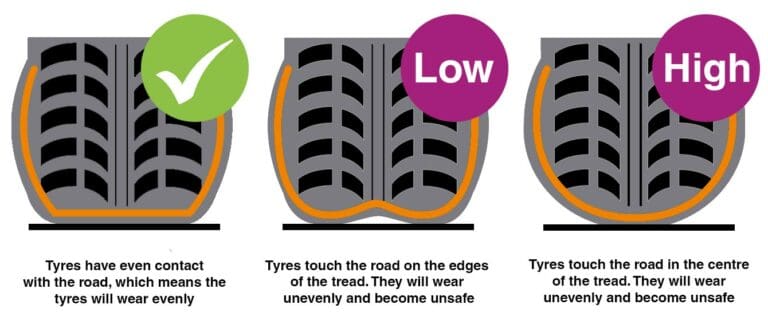
How would under inflated tyres affect your vehicle
If your tyres are under inflated, then it could be dangerous. This is because tyres will flex more as they get hotter if they are under inflated. This means getting a flat tyre is more likely.
If your tyres are under inflated, then you will need to leave a larger stopping distance to keep you safe. It will also affect the way your vehicle handles, and could cause steering problems, which makes collisions more likely!
Because of the way an under inflated tyre sits on the road it will mean that the tyre tread will not wear evenly, in fact it will wear mostly on the edges of the tread. It will also increase your tyres rolling resistance, which is the amount of energy needed to move the tyre over a distance, which would increase fuel consumption.
Can I drive on low tyre pressure?
It’s advised not to drive on tyres with low pressure. When tyres have low air pressure then the walls of the tyre move more than they should, meaning it’s more likely you will get a flat tyre. Getting a flat tyre at high speed can be extremely dangerous and could cause a crash, so make sure your tyres are pumped up to the correct pressure.
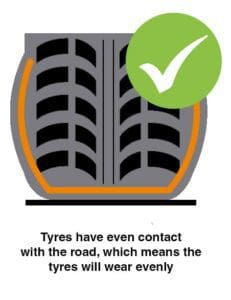
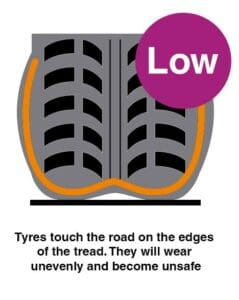
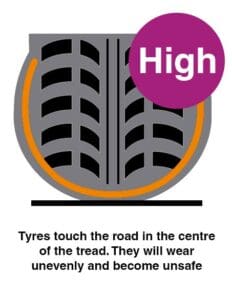
Is it ok to over inflate tyres?
Just like under inflated tyres, over inflated tyres can cause safety risks and also your tyres to wear unevenly. Although over inflating your tyres won’t increase the risk of getting a flat tyre, the high pressure will make the ride harsher and more uncomfortable for all. Only ever reduce the pressure in the tyres to what is recommended.
The dangers of over inflation include the tyres wearing in the centre of the tread and not the centre and the outside, meaning they will wear unevenly and need to be changed more frequently. It also means your tyres will have less contact area with the road which will reduce traction and grip, meaning you will have less control of the road whilst driving.
Ensuring your tyres are inflated correctly and to the right pressure will keep them in good condition for longer, and in turn costing you less. It is also extremely important to check your tread on your tyres so that they also have enough grip and traction on the road. Looking after your car, van or motorbike, goes a long way in helping you keep your vehicles value and keeping you safe on the road.
Is it ok to over inflate tyres?
Just like under inflated tyres, over inflated tyres can cause safety risks and also your tyres to wear unevenly. Although over inflating your tyres won’t increase the risk of getting a flat tyre, the high pressure will make the ride harsher and more uncomfortable for all. Only ever reduce the pressure in the tyres to what is recommended.
The dangers of over inflation include the tyres wearing in the centre of the tread and not the centre and the outside, meaning they will wear unevenly and need to be changed more frequently. It also means your tyres will have less contact area with the road which will reduce traction and grip, meaning you will have less control of the road whilst driving.
Ensuring your tyres are inflated correctly and to the right pressure will keep them in good condition for longer, and in turn costing you less. It is also extremely important to check your tread on your tyres so that they also have enough grip and traction on the road. Looking after your car, van or motorbike, goes a long way in helping you keep your vehicles value and keeping you safe on the road.
Do they check tyre pressure on MOT?
No, a mechanic will not check tyre pressure on an MOT. However an MOT does check that all systems are working in the car, so if your car has a Tyre Pressure Monitoring System (TPMS) and this fails or is not working as it should, the MOT will fail.
Our advice would also be to make sure you don’t fail your MOT on silly things you could change yourself.
Do they check tyre pressure on MOT?
No, a mechanic will not check tyre pressure on an MOT. However an MOT does check that all systems are working in the car, so if your car has a Tyre Pressure Monitoring System (TPMS) and this fails or is not working as it should, the MOT will fail.
Our advice would also be to make sure you don’t fail your MOT on silly things you could change yourself.
Frequently asked tyre pressure questions
What are the different tyre pressure measurements?
There are 3 different tyre pressure measurements, these are: PSI, BAR and KpA. Depending on your car and the gauge you use, it could show as any of these measurements, however PSI tends to be the most regularly used.
1 PSI ~ 0.068 BAR ~ 6.8 KpA
As most cars have a recommended PSI between 31 and 35, we’ve got the conversions into BAR and KpA below for you:
31 PSI ~ 2.13 BAR ~ 213 KpA
32 PSI ~ 2.2 BAR ~ 220 KpA
33 PSI ~ 2.27 BAR ~ 227 KpA
34 PSI ~ 2.34 BAR ~ 234 KpA
35 PSI ~ 2.41 BAR ~ 241 KpA
How to check tyre pressure without a gauge?
Touching the wheels or hand pressure as it’s also known is one way in which you can check tyre pressure without a gauge. Simply press down hard on the tyre with your foot or hand and see if it feels soft, if it does then you need to inflate your tyres. If it feels firm then the tyres are good to drive on.
You can also check your tyre pressure from looking at the tyres. Park the car on a flat surface and look to see if there are any parts of the tyre sticking out. Even if you notice it only slightly, this is a sign that your tyres need inflating.
Do all petrol stations have air pumps?
Not all, but most petrol stations will have air pumps. There will be one locally to you that does, so get to know where it is for when you need to pump up your tyres.
Some do require a small fee of around £1, and some are free to use.
What does E1 mean on a tyre pressure machine?
E1 on a tyre pressure machine is an error code. It can mean several things including that the air plug is disconnected, the pump is applied too loosely to the valve or there is air leaking from the valve.
If you see this error code, don’t panic and just try to connect the pump again to see if it stops the error code from showing.
Frequently asked tyre pressure questions
What are the different tyre pressure measurements?
There are 3 different tyre pressure measurements, these are: PSI, BAR and KpA. Depending on your car and the gauge you use, it could show as any of these measurements, however PSI tends to be the most regularly used.
1 PSI ~ 0.068 BAR ~ 6.8 KpA
As most cars have a recommended PSI between 31 and 35, we’ve got the conversions into BAR and KpA below for you:
31 PSI ~ 2.13 BAR ~ 213 KpA
32 PSI ~ 2.2 BAR ~ 220 KpA
33 PSI ~ 2.27 BAR ~ 227 KpA
34 PSI ~ 2.34 BAR ~ 234 KpA
35 PSI ~ 2.41 BAR ~ 241 KpA
How to check tyre pressure without a gauge?
Touching the wheels or hand pressure as it’s also known is one way in which you can check tyre pressure without a gauge. Simply press down hard on the tyre with your foot or hand and see if it feels soft, if it does then you need to inflate your tyres. If it feels firm then the tyres are good to drive on.
You can also check your tyre pressure from looking at the tyres. Park the car on a flat surface and look to see if there are any parts of the tyre sticking out. Even if you notice it only slightly, this is a sign that your tyres need inflating.
Do all petrol stations have air pumps?
Not all, but most petrol stations will have air pumps. There will be one locally to you that does, so get to know where it is for when you need to pump up your tyres.
Some do require a small fee of around £1, and some are free to use.
What does E1 mean on a tyre pressure machine?
E1 on a tyre pressure machine is an error code. It can mean several things including that the air plug is disconnected, the pump is applied too loosely to the valve or there is air leaking from the valve.
If you see this error code, don’t panic and just try to connect the pump again to see if it stops the error code from showing.
Bringing you tips on buying and maintaining your vehicle to make life on the road less stressful.
More from Moneybarn...
For a better road ahead
Moneybarn is a member of the Finance and Leasing Association, the official trade organisation of the motor finance industry. The FLA promotes best practice in the motor finance industry for lending and leasing to consumers and businesses.
Moneybarn is the trading style of Moneybarn No. 1 Limited, a company registered in England and Wales with company number 04496573. The registered address is Athena House, Bedford Road, Petersfield, Hampshire, GU32 3LJ.
Moneybarn’s VAT registration number is 180 5559 52.
Moneybarn No. 1 Limited is authorised and regulated by the Financial Conduct Authority (Financial Services reference No. 702780)




